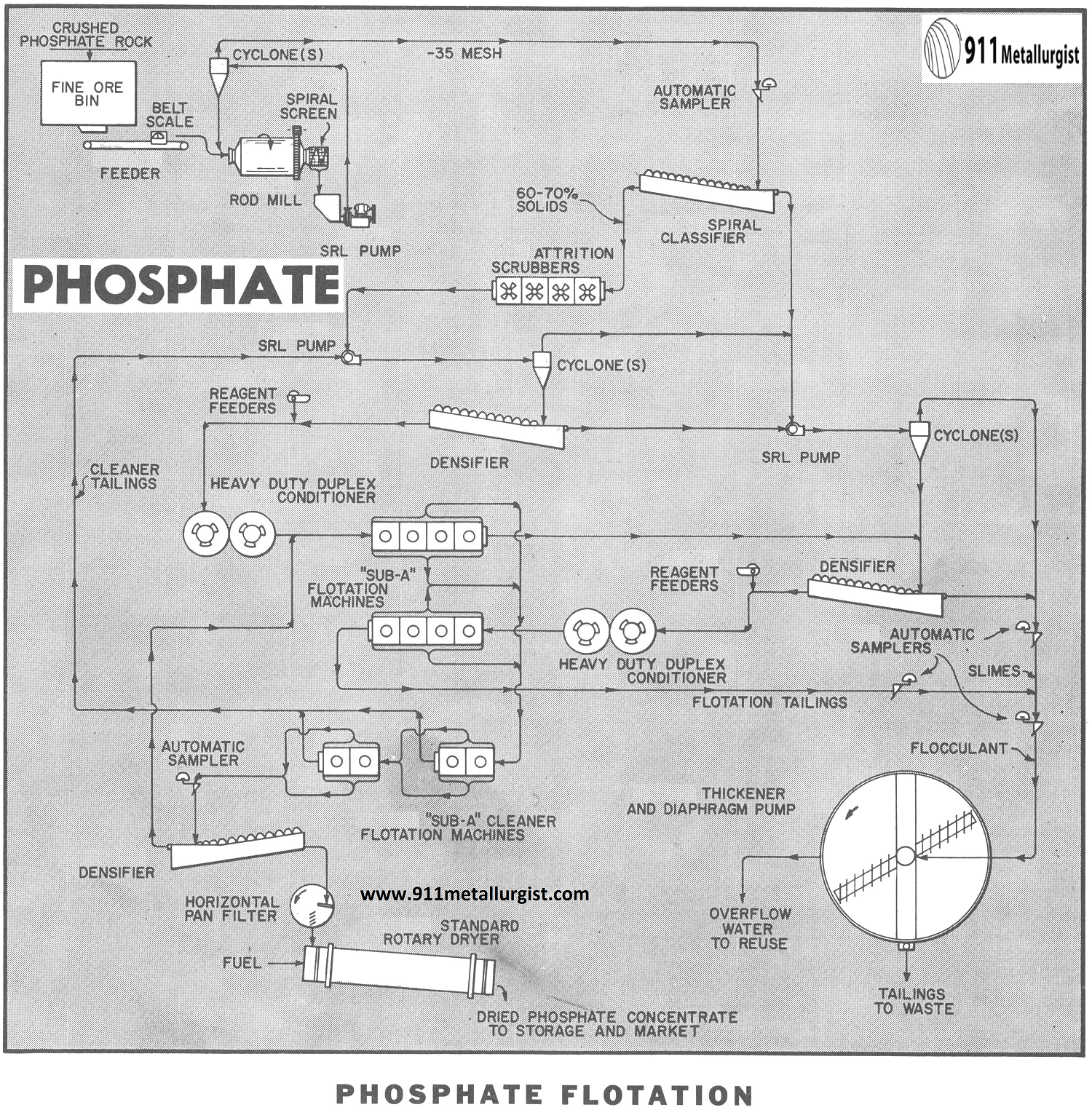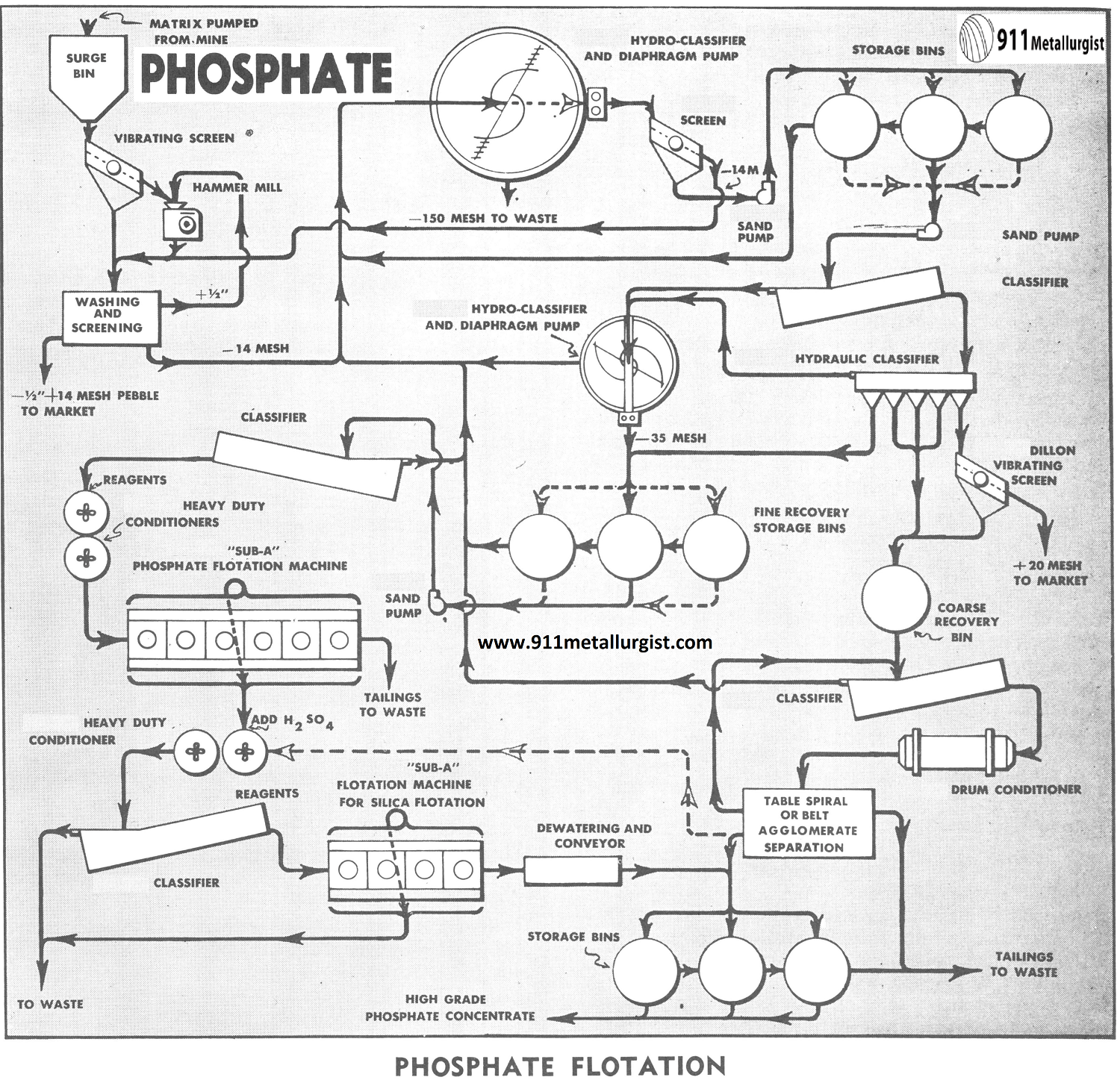Table of Contents
The phosphate-bearing formations in the West constitute relatively thick beds of phosphatic sandstones and shales that can be mined on a large scale employing open pit methods. The mineralogical characteristics vary considerably and require various treatment conditions for specific areas. For Phosphate, flotation is, in general, very important to upgrading the phosphate rock and is employed in this study to beneficiate a 20% P2O5 feed content to a 30-32% P2O5 content.
The growing fertilizer industry has increased the demand for phosphate rock from which super-phosphates are produced. The fertilizer market is very competitive. Transportation costs and market specifications are often important factors. The phosphate beds in the Western United States comprised of Utah, Wyoming, Idaho, and Montana have received increasing interest and exploitation to fulfill the agricultural needs in the West and in the Mississippi Basin.
The Phosphate Flotation Flowsheet
The flowsheet in this study is applicable to treating certain Western phosphate ores although some modifications may be necessary in specific instances. Truck haulage to the mill is common practice. Crushing, which is not shown on the flowsheet described, is usually accomplished using conventional jaw crushers for primary reduction and then impact or cone-type crushers for secondary reduction in closed circuit with vibrating screens.
Phosphate GRINDING
Wet rod mill grinding to approximately 35-mesh is employed as only a moderate degree of grinding is required and the production of slimes must be minimized to effect maximum recovery. The Rod Mill operating in closed circuit with a Cyclone Classifier is effective in accomplishing the liberation of the phosphate minerals.
Phosphate DESLIMING
The complete removal of slimes is essential to successful phosphate flotation. The cyclone classifier overflow is partially deslimed and densified using a Spiral Classifier. The deslimed sands at uniform density from the spiral classifier are subjected to attrition scrubbing at approximately 60-70% solids to thoroughly clean the mineral particles of slime – producing material. A 4-cell Attrition Scrubber is used for this purpose. The discharge from the scrubber is thoroughly deslimed using cyclones which produces a slime – free sand underflow for flotation.
Phosphate FLOTATION
The cyclone underflow which varies in its density is discharged to a Spiral Densifier to produce a uniform and dense feed to the Heavy Duty Duplex Conditioner. Reagents (fuel oil and fatty acid) are added to the conditioner which is operated at 60 to 70% solids. Flotation is accomplished at 30% solids in two stages with intermediate densification and conditioning with additional reagents for optimum recovery. The free flow type “Sub-A” Flotation Machine with supercharged air is used due to the high tonnages that must be handled. Double overflow machines are used for the rapid removal of froth because a large proportion of the feed reports as concentrate. Flotation is very fast if the feed is properly deslimed and conditioned. The large tonnages usually treated require several parallel flotation sections but only one section is shown on the flowsheet for simplicity.
Double cleaning of the froth without additional reagents is illustrated to insure a uniform product meeting market specifications. The cleaner tailings are returned to the head of the rougher flotation circuit and subjected to desliming and conditioning before being retreated. Unlike the practice often required in the Florida phosphate area, the flotation concentrates are not subjected to reflotation for the removal of silica as a froth product.
The flowsheet shows the overflows from the first two cyclones and the primary densifier being recycloned with the final overflow going to the tailing thickener. The cyclone underflow is fed to the second stage of flotation. This extra cyclone step functions as a scavenger for fine phosphate particles that may have been rejected in the initial desliming phases.
FILTERING AND DRYING Phosphate
The cleaned flotation concentrate filters very rapidly due to its granular and deslimed characteristics. A horizontal vacuum pan filter is ideal for this application. Drying, which is required by market specifications and freight charges, is accomplished by a concurrent direct fired Rotary Dryer. The dried concentrates are stored preparatory to shipment.
Phosphate TAILING DISPOSAL
The flowsheet shows the entire tailing being thickened for the recovery of water for reuse. The slimes require flocculation for settling in the thickener due to their earthy clay-like composition. The thickener underflow is pumped to the tailing pond.
SAMPLING
The feed, final concentrate, slime tailing, flotation tailing, and composite tailing represent the key points for automatic sampling. Reliable samples cut at 15 minute intervals are essential to efficient operation.
Testing Phosphate in LABORATORY
Phosphate deposits vary considerably throughout the world and represent a challenge to the metallurgist. Simple washing and screening techniques apply to some ores whereas flotation is often required for other ores. Granular phosphate particles ( — 20, +35 -mesh) require reagentizing and agglomerate separation using tabling, spiraling, and other methods. Calcining is sometimes effective to remove organic matter or other gangue constituents. Therefore, thorough test work is a prerequisite to any successful phosphate milling operation.
Summary
Description of Ore: Phosphatic sandstone and shale.
Assay of Ore: 20.0% P2O5
Method or Process: “Sub-A” Flotation
Concentrate and Recovery:
Cleaned Flotation…………………….31.0% P2O5
Recovery…………………………………70.0%
Reagent, Lbs. Per Ton:
Fatty acid………………………………….0.7
Fuel oil…………………………………….0.5
Miscellaneous Data: Grind —35 mesh, scrubbed and thoroughly deslimed prior to flotation at a pH of 8 to 9. Caustic soda is
sometimes used in conjunction with the fatty acid and fuel oil.

Source: This article is a reproduction of an excerpt of “In the Public Domain” documents held in 911Metallurgy Corp’s private library.
